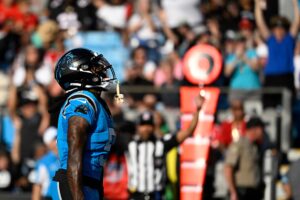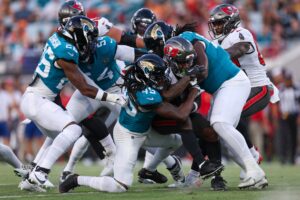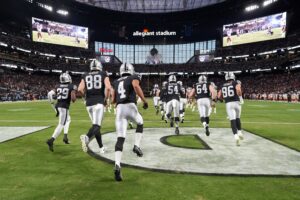At this point, every NFL fan probably knows the name Taysom Hill. Predominantly used as a gadget player before future Hall of Famer Drew Brees’s injury this season, the 30-year-old Hill has more than proven himself an electric playmaker in the New Orleans Saints offense. With that said, Hill was unable to prove himself as a truly effective passer preceding his Week 11 debut as a starter under center. While Denver Broncos fans might consider the BYU alumnus a player somewhat reminiscent of former Bronco Tim Tebow, Hill’s performance against the Atlanta Falcons (who defeated the Broncos in Week 9, mind you) suggests Vic Fangio and his defense have their work cut out for them when it comes to how the Denver Broncos contain Taysom Hill on Sunday.
How the Denver Broncos Contain Taysom Hill
How the New Orleans Saints Helped Taysom Hill
Before one can effectively understand how Denver can stymie an offense that produced 24 first downs, 168 rushing yards, three rushing scores, and 233 passing yards with a first-time starter under center, one must understand what Sean Payton did to help Taysom Hill debut as successfully as he did.
The offense was not all that drastically different than it was with Drew Brees at the helm, save for the added dimension of consistent (i.e., Hill remaining on the field for every offensive play instead of coming in for a handful of plays at a time) rushing capability from the quarterback position. The Taysom Hill-led offense saw quite a bit of movement all over the place— pre-snap motions, pulling offensive linemen, flash blocks from tight ends, crossing routes, etc.
Combining this level of movement with designed rollouts and a wide variety of more horizontal play designs (which helps limit the effectiveness of defenses with four or more down linemen), it is unsurprising Hill was able to maintain a mostly mistake-free stat-line against Atlanta. Additionally, there were a significant number of quick passes to limit the risk of turnovers and keep Hill in a rhythm with a high completion percentage, a strategy Payton also uses to compensate for the declining arm strength of Drew Brees. In fact, Hill finished the game with a completion percentage of 78.26, which is higher than Drew Brees’s percentage in two-thirds of his games this season.
Prince of Play-Action
Perhaps most importantly, however, was the liberal use of play-action passes. Entering the game, New Orleans was only employing play-action on 16% of its offensive snaps, good for third-lowest in the entire league. Against Atlanta? About 40%! According to Pro Football Focus, Hill completed nine of ten such passes, accruing 168 yards (72.1 percent of his total passing yardage). He also had a 57-yard passing score off of play-action called back on a penalty.
When one considers the differential between Hill’s yards per attempt on play-action and normal passing attempts, the numbers become even more staggering: 16.8 yards per attempt on play-action compared to a mere five yards per attempt on standard passing plays.
To contain Taysom Hill, the Broncos defense must work as a cohesive and disciplined unit against both the run and the pass.
Limiting Hill as a Runner
Against Atlanta, the Saints employed a surprisingly low number of designed quarterback runs. Most of Hill’s statistics in the run game came as a result of scrambling out of the pocket, which serves to further illustrate Sean Payton’s faith in Taysom Hill as a quarterback and not just a gadget player. Despite the low number of designed runs, Hill accrued 51 yards and two scores on the ground. Containing Hill as a runner is pivotal to containing Hill as a passer and to the Broncos winning the game in general.
To counteract Hill’s effectiveness as a runner, the Broncos must consider utilizing a spy in their defensive gameplan. The ideal fit is an athletic linebacker with the size and strength to beat blocks, but also with the speed to get to the edge in case Hill (or Alvin Kamara) breaks outside, which sounds remarkably like Alexander Johnson, a true sideline-to-sideline interior backer.
Why the Spy?
Using a spy would limit Hill’s ability to scramble out of collapsing pockets (of which there will be many, Broncos Country hopes), but it would also limit checkdown options for a passing attack predicated on quick and short throws. If the linebackers and safeties can maintain disciplined eyes, they should be able to more efficiently key off of the pulling offensive linemen, making it harder for Hill and the running backs to receive adequate lead blocking.
Deploying a spy in conjunction with good interior pressure and effective edge defense, the Broncos defense should be able to limit Hill’s effectiveness as a runner throughout the field. In the redzone, where the majority of Hill’s designed runs took place, the Broncos boast one of the best defenses in the league, particularly against the run.
So long as they stay disciplined and focus on executing their individual responsibilities, it is not unreasonable to expect the defense to frustrate Taysom Hill as a runner.
Limiting Hill as a Passer
If the Broncos can successfully stop the New Orleans run game—Taysom Hill and the running backs alike—it will pay significant dividends against the Saints passing attack. Considering the sheer volume of play-action Sean Payton called against Atlanta, preventing the run game from finding a rhythm would limit the effectiveness of play-action passes.
By allowing the safeties to bite up a bit, as if to dare Hill to throw deep (where he lacks timing and has proven inaccurate), the horizontal aspect of the passing offense would find itself in jeopardy. With Justin Simmons and Kareem Jackson, two formidable and reliable tacklers, closer to the line of scrimmage, the chances of an interception on in-breaking routes shorter than 10-15 yards significantly increase. It should prevent chunk plays in the run game as well.
Alignment and Technique
The defense also needs to focus on edge defenders’ depth when rushing the passer. Against Atlanta, Hill was often able to step up into the pocket to escape for a run or throw a deeper pass than his typical arsenal because the edge defenders pursued far too deep into the backfield. Bradley Chubb and Malik Reed must remain disciplined while setting the edge to prevent Hill from stepping up into throwing and running lanes.
Combine this effective edge defense with a continuation of the interior pressure the Broncos were able to apply against the Miami Dolphins, and it should yield more traditional sacks, as opposed to coverage sacks. Getting pressure and hits on Taysom Hill in the way Atlanta failed to last week is crucial to limiting his effectiveness as a passer.
To help combat condensed formations, crossing routes, and the quick-hitch, horizontal style of the New Orleans offense with Hill under center, Denver must also explore an increase in press coverage with staggered defensive back alignment.
2019’s season opener against the then Oakland Raiders (now the Las Vegas Raiders) and the 2020 season opener against the Tennessee Titans have proved Fangio’s somewhat bizarre commitment to substantial cushions for defensive backs is completely ineffectual against strong running games and play-action-based offenses, especially ones with a focus on quick throws. Since this perfectly describes the Taysom Hill-led Saints offense, Fangio cannot afford to be stubborn on this.
If Taysom Hill cannot find a rhythm as a passer, the Broncos most likely would continue their 22-year undefeated streak against New Orleans.
Last Word
It might not be possible to fully contain Taysom Hill. But if the Broncos can apply the aforementioned strategies to their defensive gameplan, they can certainly limit his effectiveness.
Whether or not the Broncos can limit Hill as both a passer and a runner remains to be seen; with that said, the New Orleans offense with number seven at the helm is entirely predicated on an effective run game. What the Broncos have to do is stop the run, force them into the gun, and run wild with Vic Fangio’s infamous and intricate designs in the defensive backfield.
This young team might not have had the moxie to defeat the veteran savvy of Drew Brees, but against Taysom Hill?
Time will tell.
Main photo:
Embed from Getty Images






